Africa, June 2001
Some pictures are included on this page, but the full set of "top 10%" pictures is available here. If you think you want to see all the photos, go here.
Getting to Africa
After leaving Maria and Sarah with my parents we flew to Atlanta. The next day we fly from Atlanta to Johannesburg and then went in a chartered plane to Kasane in the Northeast tip of Botswana. What these words fail to convey is the distances involved. With the exception of the Kerguelen Islands and Antarctica, Johannesburg is about as far from Seattle - 16,500 km - as it is possible to go without leaving the Earth's surface. Even distant Perth is 1,700 km closer.
The flight from Atlanta to Johannesburg is the longest
non-stop flight in the world, at 13,600 km. It requires a
special 747, and an extremely long runway to let the
heavily loaded plane gain speed. The long runway at
Atlanta was shut down for maintenance, so our plane had to
break the trip up into segments - Atlanta to Sal Island
(Cape Verde) to Cape Town to Johannesburg.
 Thus, our quick
18-hour jaunt across the Atlantic ended up taking 22
hours. You know it's a long flight when you watch four
movies and three sitcoms and you still spend most of the
flight with nothing to do.
Thus, our quick
18-hour jaunt across the Atlantic ended up taking 22
hours. You know it's a long flight when you watch four
movies and three sitcoms and you still spend most of the
flight with nothing to do.
Mowana Safari Lodge, Botswana
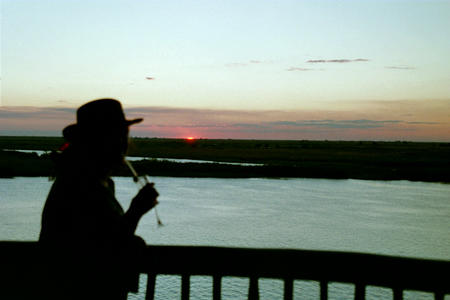 Drinks were
waiting for us at the bar overlooking the river, our
luggage was taken to our rooms, and dinner was one of the
best buffets I've ever had. Of course, an African buffet
tends to include some local animals - like ostrich, kudu,
impala, crocodile and buffalo - and I'm not one to let my
vegetarian tendencies stop me from enjoying unique
opportunities.
Drinks were
waiting for us at the bar overlooking the river, our
luggage was taken to our rooms, and dinner was one of the
best buffets I've ever had. Of course, an African buffet
tends to include some local animals - like ostrich, kudu,
impala, crocodile and buffalo - and I'm not one to let my
vegetarian tendencies stop me from enjoying unique
opportunities.
While at Mowana we went on a boat safari and two jeep
safaris. These safaris are wonderful beyond description
and I can only hope that our pictures - half of our photos
came from these three safaris - help convey the sense of
wonder.
 We saw beautiful bee eater birds, weaver bird
nests, impala and kudu, herds of elephants and hippos,
hyenas, warthogs,
We saw beautiful bee eater birds, weaver bird
nests, impala and kudu, herds of elephants and hippos,
hyenas, warthogs,
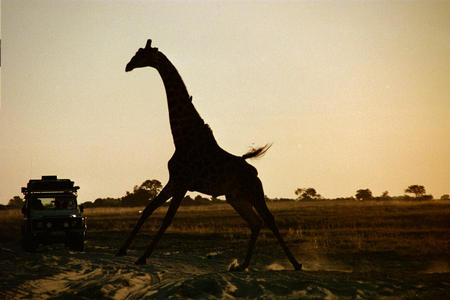 giraffes running across the savanna,
giraffes running across the savanna,
 lions running, roaring
lions running, roaring
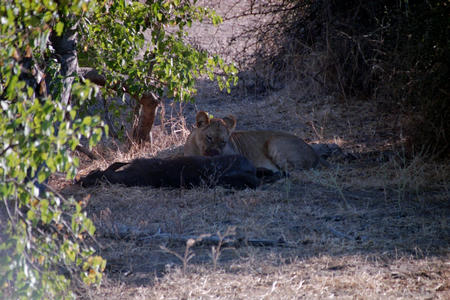 and eating (a buffalo) and so much
more
and eating (a buffalo) and so much
more
 We watched a herd of elephants playing in the water,
a baby elephant nursing
We watched a herd of elephants playing in the water,
a baby elephant nursing
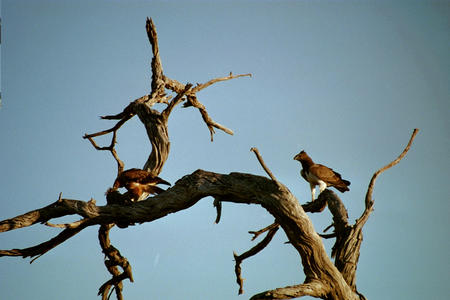 and two eagles fighting over who
got to eat a guinea fowl. Wow.
More safari pictures are
available here.
and two eagles fighting over who
got to eat a guinea fowl. Wow.
More safari pictures are
available here.
Victoria Falls, Zimbabwe
 After Mowana Safari Lodge we crossed the border into
Zimbabwe (formerly Southern Rhodesia) and drove to
Victoria Falls. Victoria Falls is truly a natural wonder.
At 1.7 kilometers wide it's twice as wide and twice as high
as Niagara Falls. However it is more than that. Because of
the geology of the region - narrow strips of soft
limestone separated by hard basalt - the water falls into
a very narrow gorge. You can
walk almost the entire length of the falls, less than a
hundred meters from the crashing water.
After Mowana Safari Lodge we crossed the border into
Zimbabwe (formerly Southern Rhodesia) and drove to
Victoria Falls. Victoria Falls is truly a natural wonder.
At 1.7 kilometers wide it's twice as wide and twice as high
as Niagara Falls. However it is more than that. Because of
the geology of the region - narrow strips of soft
limestone separated by hard basalt - the water falls into
a very narrow gorge. You can
walk almost the entire length of the falls, less than a
hundred meters from the crashing water.
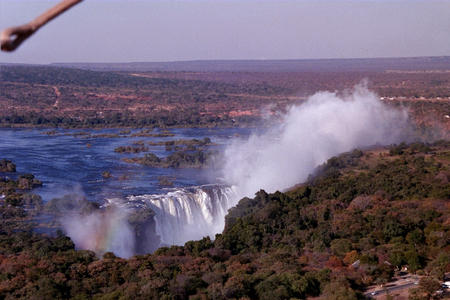 The mist from the
falls goes hundreds of meters into the air and is visible
twenty kilometres away. Across the gorge the mist varies from a
light spray to a torrential rainfall - that never stops.
Properly enjoying Victoria Falls requires that you get
completely soaked - just make sure that you have a
seriously waterproof container for your camera.
The mist from the
falls goes hundreds of meters into the air and is visible
twenty kilometres away. Across the gorge the mist varies from a
light spray to a torrential rainfall - that never stops.
Properly enjoying Victoria Falls requires that you get
completely soaked - just make sure that you have a
seriously waterproof container for your camera.
Unfortunately, the town outside the falls is the worst
kind of tourist trap. Our hotel - the Kingdom - looked
like a Las Vegas conception of Africa, complete with
miniature versions of Victoria Falls and Great Zimbabwe -
and the mandatory casino. Outside the hotel there were
beggars and moneychangers constantly pulling at your
sleeves.
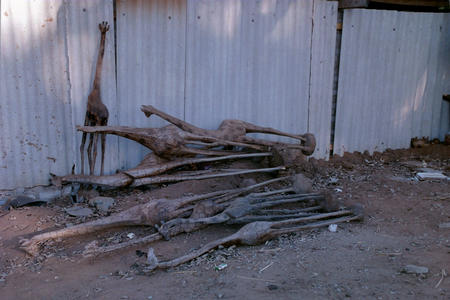 The local craft market had the worst kind of mass
produced repetition, and even the haggling was no fun.
The local craft market had the worst kind of mass
produced repetition, and even the haggling was no fun.
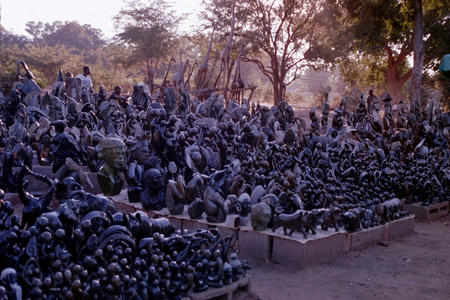
We skipped the bungee jumping, went on an elephant ride, a balloon ride (for the aerial view of the falls) and had dinner at the Victoria Falls Hotel - a much more sedate and classy establishment than our hotel. I also went river rafting, and we did find some nice souvenir shops. Victoria Falls is worth visiting - the falls are an amazing site - but you can miss the other attractions there without too much worry.
Eclipse viewing, Zimbabwe
It was an all day bus ride to Kariba, but I never tired of the scenery. Every few miles we would drive by a tiny African village - a few mud brick huts, with thatched roofs, a stockade made of sticks, and a storage hut up on poles. They looked perfect, beautiful, and timeless.
We got to the border crossing after it had officially
closed, so we bribed the guards with eclipse viewing
glasses and continued on to our hotel. In Kariba our hotel
was a couple of houseboats. They were very simple, just a
long hallway with tiny rooms on each side, open to the
outdoors, with mosquito netting over the bed.
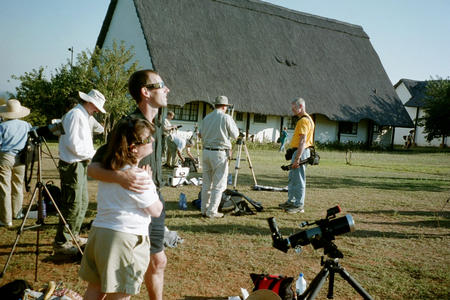 The next day was June 21 - eclipse day. Everyone was given
eclipse viewing glasses which let us stare directly at the
sun as the black disk of the moon gradually moves across
it.
The next day was June 21 - eclipse day. Everyone was given
eclipse viewing glasses which let us stare directly at the
sun as the black disk of the moon gradually moves across
it.
The nice thing about going on an eclipse tour is that the other eclipse fanatics are happy to let you use their fancy toys. A number of telescopes were setup with solar filters so that we could view the sun clearly. At high magnification there were dozens of sun spots visible, and if you watched the moon's disk near a sun spot for about twenty seconds you could see the black circle moving. You could also see, silhouetted against the sun, the slightly jagged edge of the moon - mountain ranges a quarter million miles away.
The low-tech way of viewing a solar eclipse is with a
pinhole camera, and there were many setup. One person was
projecting an image of the 'crescent sun' onto the side of
a building. Another person had made dozens of pinhole
cameras in a piece of cardboard, spelling out "Eclipse
2001 Africa" in projected crescents.
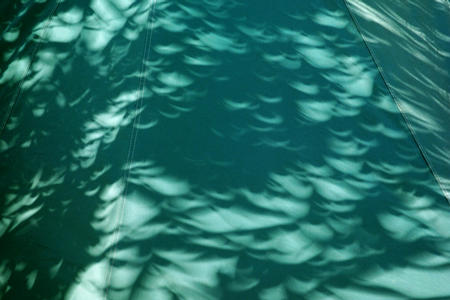 Finally, every leafy
tree has hundreds of tiny gaps between leaves, and these
project the image of the sun onto any flat surface below
them.
Finally, every leafy
tree has hundreds of tiny gaps between leaves, and these
project the image of the sun onto any flat surface below
them.
The next three pictures were not taken by us. It's
best to concentrate on watching the eclipse, rather than
fussing with your camera.
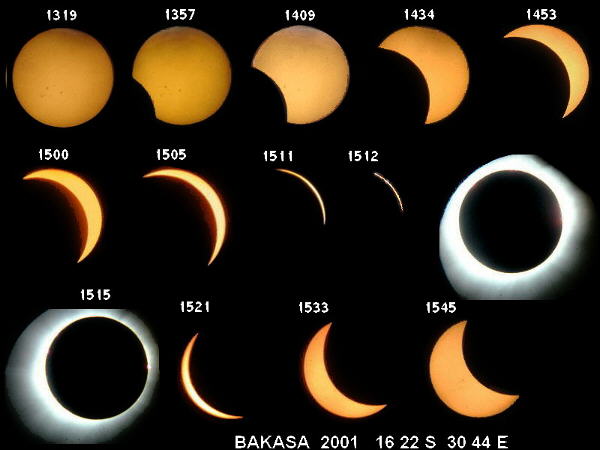 It takes about an hour and a half from "first contact" -
when the moon first takes a bite out of the sun - to
"second contact", when the sun completely disappears and
the total eclipse begins. During this time the sun gets
more hidden, it gradually gets darker, but nothing
dramatic happens. One couple used this time to get
married, in a tower overlooking the Africa savanna and
baobab trees.
It takes about an hour and a half from "first contact" -
when the moon first takes a bite out of the sun - to
"second contact", when the sun completely disappears and
the total eclipse begins. During this time the sun gets
more hidden, it gradually gets darker, but nothing
dramatic happens. One couple used this time to get
married, in a tower overlooking the Africa savanna and
baobab trees.
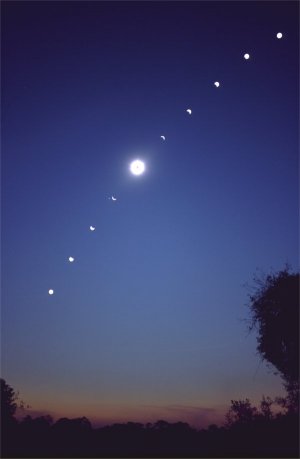 As the last of the sun sneaks behind the moon, the special
effects that are only available with a total solar eclipse
begin. It got as dark as twilight and Jupiter and Sirius
appeared. As the last fragment of sun shone through a deep
lunar canyon, the intense point of light together with the
coronal ring looks like a brilliant diamond ring, shining
in the sky. When the last diamond disappears the corona
becomes visible - wispy streamers of light spreading out
far beyond the sun. A couple of pinpoints of red light
were visible with the naked eye - they were solar
prominences - huge jets of plasma, faintly visible with
the naked eye.
As the last of the sun sneaks behind the moon, the special
effects that are only available with a total solar eclipse
begin. It got as dark as twilight and Jupiter and Sirius
appeared. As the last fragment of sun shone through a deep
lunar canyon, the intense point of light together with the
coronal ring looks like a brilliant diamond ring, shining
in the sky. When the last diamond disappears the corona
becomes visible - wispy streamers of light spreading out
far beyond the sun. A couple of pinpoints of red light
were visible with the naked eye - they were solar
prominences - huge jets of plasma, faintly visible with
the naked eye.
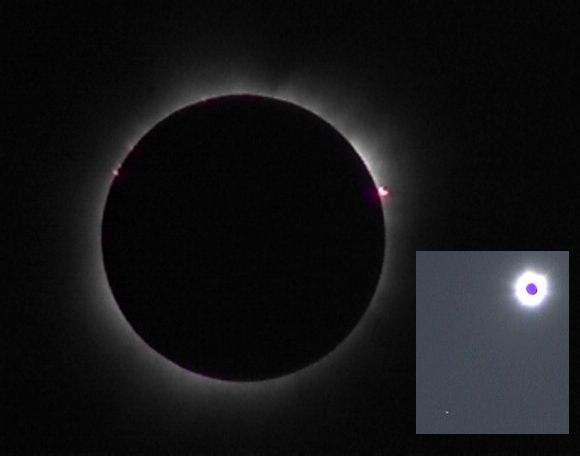 An annotated version of this picture by Olivier Staiger
can be seen
here.
An annotated version of this picture by Olivier Staiger
can be seen
here.
A good explanation of what happens and what you see during
a total eclipse - including the wonderful "diamond ring
effect" can be found here.
Canoeing on the Zambezi, Zimbabwe
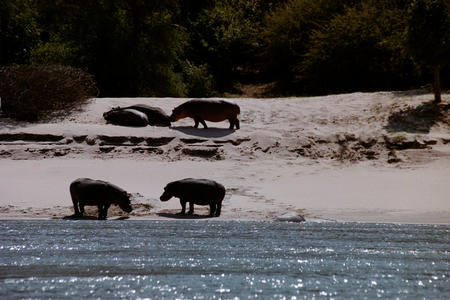 The first thing we learned about our canoeing trip is that
the Zambezi is home to hippos. A lot of hippos. Thousands
of hippos. In fact, canoeing on the Zambezi is all about
dodging hippos.
The first thing we learned about our canoeing trip is that
the Zambezi is home to hippos. A lot of hippos. Thousands
of hippos. In fact, canoeing on the Zambezi is all about
dodging hippos.
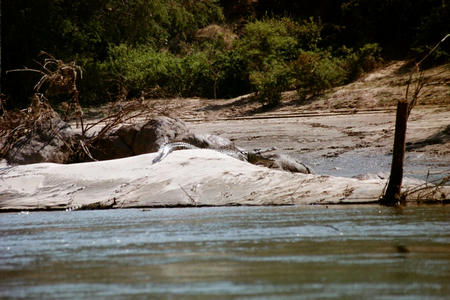 The Zambezi also has lots of crocodiles -
we saw hundreds - but they're not much of a danger unless
you try swimming. How many crocs can you see in this
picture?
The Zambezi also has lots of crocodiles -
we saw hundreds - but they're not much of a danger unless
you try swimming. How many crocs can you see in this
picture?
As Canadians with a good classical education Helen and I are, of course, expert canoeists. However, five of the other tourists had never been in a canoe, and two of them didn't know how to swim. They took a pretty circuitous path down the river that first day, but they had a pretty strong incentive to quickly master the art of steering.
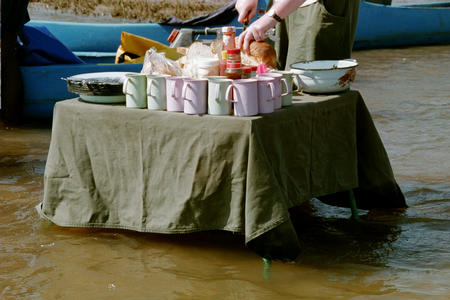 The first morning out one of the canoes got wedged in a
small waterfall and filled with water (oddly enough, it
was the guides canoe!) so we had to stop in shallow water
in the middle of the river while the guide retrieved the
items that had floated away. When he returned he decided
that lunch would be served where we were - on a sandbar
that was six inches under water. It turns out that once
you put out your folding table, and table cloth, it makes
for a magical lunch location.
The first morning out one of the canoes got wedged in a
small waterfall and filled with water (oddly enough, it
was the guides canoe!) so we had to stop in shallow water
in the middle of the river while the guide retrieved the
items that had floated away. When he returned he decided
that lunch would be served where we were - on a sandbar
that was six inches under water. It turns out that once
you put out your folding table, and table cloth, it makes
for a magical lunch location.
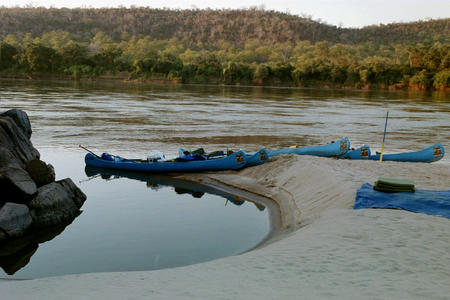 Beautiful locations were definitely part of the canoeing
experience. Virtually every stop was on an idyllic sand
bar, with no sign of any other humans.
Beautiful locations were definitely part of the canoeing
experience. Virtually every stop was on an idyllic sand
bar, with no sign of any other humans.
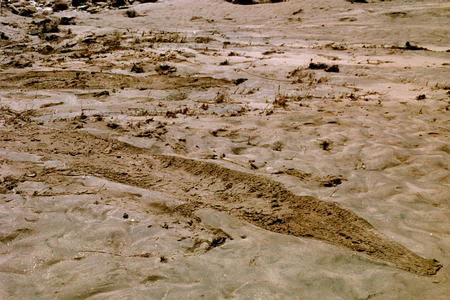 One lunch stop was on a slightly muddier shore and we
discovered imprints in the mud from where four crocodiles
had recently been dozing - no surprise since we frequently
saw them sliding into the water when we got too close. One
of the imprints was a healthy ten feet long.
One lunch stop was on a slightly muddier shore and we
discovered imprints in the mud from where four crocodiles
had recently been dozing - no surprise since we frequently
saw them sliding into the water when we got too close. One
of the imprints was a healthy ten feet long.
Part of the North American camping ritual is sitting around a campfire and telling ghost stories. Afterwards you lie in your tent trying to remind yourself that the stories aren't true and that there's nothing to be afraid of.
The African camping ritual is similar. You sit around your candle (no campfires in the national park) while the guide tells stories about tourists being eaten by lions and crocodiles or getting mauled by hippos. Then you lie in your tent reminding yourself that the stories are true and that going outside to answer nature's call might not be such a bright idea.
We were very impressed with the professionalism of the guides and the park rangers. They took excellent care of the park.
After four days of canoeing, followed by a few hours of driving through Tsetse fly infested territory, we flew to Cape Town, South Africa.
Cape Town, South Africa
 This was the view from our hotel room.
In the city there are
whites and blacks working together, with no sign of racial
problems. However it's pretty clear, from the miles of
shantytowns on the drive in, that you are seeing the
minority of blacks who have managed to get a decent job.
This was the view from our hotel room.
In the city there are
whites and blacks working together, with no sign of racial
problems. However it's pretty clear, from the miles of
shantytowns on the drive in, that you are seeing the
minority of blacks who have managed to get a decent job.
We took a catamaran ride out to Robben Island for a tour that included "interaction with an ex-political prisoner." That sounded pretty cheesy, but in fact it was a very powerful experience. Our guide had spent 18 years at Robben Island as a political prisoner, and his lack of bitterness and belief in the importance of not blaming his former jailers was amazing. He talked a lot about the education that the prisoners gave each other, and the guards, while in the prison. We got the sense that the beliefs and principles that were forged in this prison were mainly responsible for South Africa's success so far in dealing with the end of apartheid. The main worry is that economic problems may yet derail the fragile peace.
 You can't visit Cape Town without going up Table Mountain
and I managed to convince Helen to climb it. We went right
up the middle of the side that faces Cape Town, and when I
look at our pictures now I have no idea how we made it up
- it looks like a vertical cliff face. It was a steep
climb, but there wasn't actually any rock climbing
involved.
You can't visit Cape Town without going up Table Mountain
and I managed to convince Helen to climb it. We went right
up the middle of the side that faces Cape Town, and when I
look at our pictures now I have no idea how we made it up
- it looks like a vertical cliff face. It was a steep
climb, but there wasn't actually any rock climbing
involved.
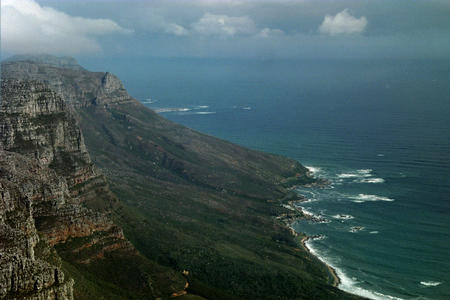 The top was covered in clouds, but whenever the
cleared for a few seconds there were glorious views down
the coast.
The top was covered in clouds, but whenever the
cleared for a few seconds there were glorious views down
the coast.
There are six plant kingdoms in the whole world, and one of them is the Cape Town area - it's a very unique ecosystem. Look for the unusual plant pictures on our full gallery page.
Two of the tourists from our canoe trip were from Cape
Town, and one of them (thanks Ed) offered to be our tour guide for a
day. He drove us to markets and wineries, and
 then out to
a penguin nesting area on False Bay. After that we went to
the Cape of Good Hope.
then out to
a penguin nesting area on False Bay. After that we went to
the Cape of Good Hope.
 The Cape of Good Hope is, quite simply, spectacular. It's
a famous cape (although not the Southern most tip of
Africa) that arguably separates the Atlantic from the
Indian oceans, and that should be enough, but it is a cape
of superlatives.
The Cape of Good Hope is, quite simply, spectacular. It's
a famous cape (although not the Southern most tip of
Africa) that arguably separates the Atlantic from the
Indian oceans, and that should be enough, but it is a cape
of superlatives.
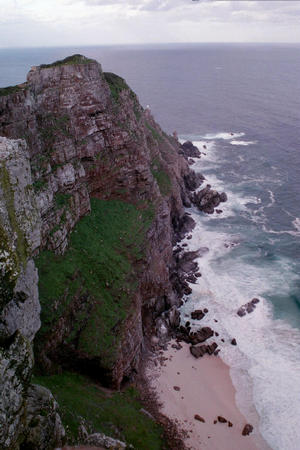 The cape is a ridiculously skinny spit of
land that rises vertically out of the water from crashing
surf and occasional perfect beaches. Whoever designed the
Cape of Good Hope clearly overdid it, and it's wonderful.
The cape is a ridiculously skinny spit of
land that rises vertically out of the water from crashing
surf and occasional perfect beaches. Whoever designed the
Cape of Good Hope clearly overdid it, and it's wonderful.
We felt very safe the whole time we were in Africa -
despite media reports of problems in Zimbabwe. The only
problem we had the whole time was when three young ladies
in Cape Town did a little magic trick - they made our bank
card disappear. We realized what had happened almost
immediately, but it only took them three minutes to run to
the next machine and take out our daily limit. We
cancelled the card, and our bank covered the losses, so
we're only out our pride.
 This map of Southern Africa should help you visualize where
we were - I've labeled the important places.
This map of Southern Africa should help you visualize where
we were - I've labeled the important places.
Then we flew back. It was another long flight. It was worth it.
Still here? Still want more? There's more of our vacation snaps available here.